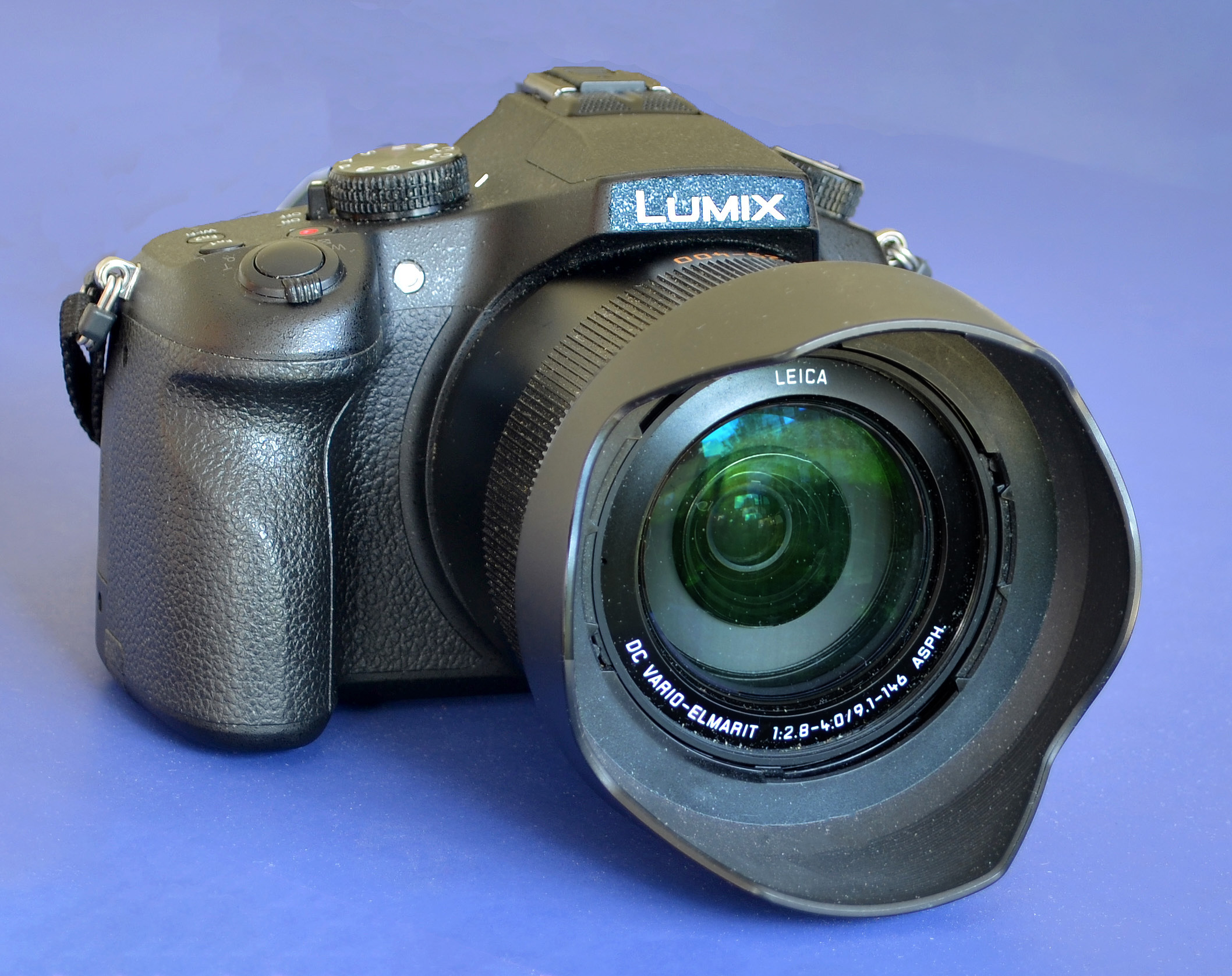bridge camera on:
[Wikipedia]
[Google]
[Amazon]

 A bridge camera is a type of
A bridge camera is a type of



# All measures are in pixels
ImageSize = width:800 height:100
PlotArea = left:90 right:10 bottom:20 top:20
AlignBars = justify
DateFormat = dd/mm/yyyy
Period = from:2013 till:2019
TimeAxis = orientation:horizontal
ScaleMajor = unit:year increment:1 start:2013
Define $dx = -40
# shift text
# Dates from DPReview
PlotData=
bar:Panasonic_Lumix color:red width:20 mark:(line,white) align:left fontsize:S
from:12/06/2014 till:16/07/2015 shift:($dx,14) text: DMC-FZ1000
from:16/07/2015 till:19/09/2016 shift:($dx,14) text: DMC-FZ300
from:19/09/2016 till:01/01/2019 shift:($dx,14) text: DMC-FZ2500 / FZ2000
bar:Sony_Cyber-shot color:blue width:20 mark:(line,white) align:left fontsize:S
from:16/10/2013 till:10/06/2015 shift:($dx,14) text: DSC-RX10
from:10/06/2015 till:29/03/2016 shift:($dx,14) text: DSC-RX10 II
from:29/03/2016 till:12/09/2017 shift:($dx,14) text: DSC-RX10 III
from:12/09/2017 till:01/01/2019 shift:($dx,14) text: DSC-RX10 IV

 A bridge camera is a type of
A bridge camera is a type of camera
A camera is an instrument used to capture and store images and videos, either digitally via an electronic image sensor, or chemically via a light-sensitive material such as photographic film. As a pivotal technology in the fields of photograp ...
that fills the niche between relatively simple point-and-shoot cameras and interchangeable-lens cameras such as mirrorless cameras and single-lens reflex camera
In photography, a single-lens reflex camera (SLR) is a type of camera that uses a mirror and prism system to allow photographers to view through the lens and see exactly what will be captured. SLRs became the dominant design for professional a ...
s (SLRs). They are often comparable in size and weight to the smallest digital SLRs (DSLR), but lack interchangeable lenses, and almost all digital bridge cameras lack an optical viewfinder
In photography, a viewfinder is a device on a camera that a photographer uses to determine exactly where the camera is pointed, and approximately how much of that view will be photographed. A viewfinder can be mechanical (indicating only direct ...
system. The phrase "bridge camera" has been in use at least since the 1980s, and continues to be used with digital camera
A digital camera, also called a digicam, is a camera that captures photographs in Digital data storage, digital memory. Most cameras produced today are digital, largely replacing those that capture images on photographic film or film stock. Dig ...
s. The term was originally used to refer to film cameras which "bridged the gap" between point-and-shoot cameras and SLRs.
Like other cameras, most current bridge cameras are digital
Digital usually refers to something using discrete digits, often binary digits.
Businesses
*Digital bank, a form of financial institution
*Digital Equipment Corporation (DEC) or Digital, a computer company
*Digital Research (DR or DRI), a software ...
. These cameras typically feature full manual controls over shutter speed
In photography, shutter speed or exposure time is the length of time that the film or digital sensor inside the camera is exposed to light (that is, when the camera's shutter (photography), shutter is open) when taking a photograph.
The am ...
, aperture
In optics, the aperture of an optical system (including a system consisting of a single lens) is the hole or opening that primarily limits light propagated through the system. More specifically, the entrance pupil as the front side image o ...
, ISO sensitivity, color balance
In photography and image processing, color balance is the global adjustment of the intensities of the colors (typically red, green, and blue primary colors). An important goal of this adjustment is to render specific colors – particularly neu ...
and metering. Generally, their feature sets are similar to consumer DSLRs, except for a smaller range of ISO sensitivity because of their typically smaller image sensor An image sensor or imager is a sensor that detects and conveys information used to form an image. It does so by converting the variable attenuation of light waves (as they refraction, pass through or reflection (physics), reflect off objects) into s ...
.
Many bridge cameras have long zoom lenses which now often start at a super wide-angle focal length of 20 or 22mm equivalent focal length (in 35mm film camera terms), so the term "bridge camera" is sometimes used interchangeably with "megazoom", " superzoom", or "ultrazoom". However, some bridge cameras have only moderate or short zooms (such as the Canon Powershot G9), while many compact cameras have superzoom lenses but lack the advanced functions of a bridge camera.
With zoom ranges and sales rapidly increasing in the early 21st century, every major camera manufacturer has at least one superzoom camera in its lineup.
Comparison to other camera types
Digital bridge cameras offer the convenience of a point-and-shoot in the form factor of a DSLR. The most notable physical similarity is the location of a bridge camera’selectronic viewfinder
An electronic viewfinder (EVF) is a camera viewfinder where the image captured by the lens is displayed on a small screen (usually LCD or OLED) which the photographer can look through when composing their shot. It differs from a live preview sc ...
(EVF): centered above the lens like a DSLR’s optical viewfinder. While many digital point-and-shoots lack a viewfinder, almost every bridge camera includes an EVF, with the exception of the Canon G3 X (that offered it as an optional accessory) and some low-end models, such as the Nikon B600.
Like point-and-shoots and unlike DSLRs, bridge cameras are mirrorless. Because there is no lens mount
A lens mount is an interface – mechanical and often also electrical – between a photographic camera body and a lens. It is a feature of camera systems where the System camera, body allows interchangeable lenses, most usually the rangefinder ...
(unlike on a mirrorless interchangeable-lens camera), the lens assembly of a bridge camera is able to extend into the body almost all the way to the sensor, making more efficient use of the space.
All current models include a power zoom lens that retracts when not in use and is controlled by a lever on the body like on a point-and-shoot, but a few past models such as the Fujifilm X-S1 and S9000 included a manual zoom lens controlled by a ring on the lens like on an interchangeable-lens camera. Unlike most point-and-shoots with a zoom lens, bridge cameras require a manual lens cap, as they do not include an automatic lens cover.
The additional size of a bridge camera compared to a compact camera makes room to fit a larger image sensor, a lens with a larger aperture
In optics, the aperture of an optical system (including a system consisting of a single lens) is the hole or opening that primarily limits light propagated through the system. More specifically, the entrance pupil as the front side image o ...
or longer zoom, or some combination of both. For example, the Sony RX100 VII (compact camera) and RX10 (bridge camera) have the same zoom range (24mm to 200mm equiv.), but the RX100 VII’s maximum aperture at 200mm is 4.5, whereas the RX10’s maximum aperture at 200mm is 2.8, which means it can collect over twice the amount of light. Likewise, the Canon SX620 (compact camera) and G3 X (bridge camera) both have a 25× optical zoom, but the G3 X’s sensor is over 4 times as large as the SX620’s. Superzoom compact cameras have reached up to 40× optical zoom, whereas bridge cameras have reached up to 125× optical zoom.
One fixed but versatile lens
Bridge cameras typically have smallimage sensor An image sensor or imager is a sensor that detects and conveys information used to form an image. It does so by converting the variable attenuation of light waves (as they refraction, pass through or reflection (physics), reflect off objects) into s ...
s, allowing their lenses also to be smaller than a 35mm or APS-C
Advanced Photo System type-C (APS-C) is an image sensor format approximately equivalent in size to the Advanced Photo System film negative in its C ("Classic") format, of 25.1×16.7 mm, an aspect ratio of 3:2 and Ø 30.15 mm field d ...
SLR lens covering the same zoom range. As a result, very large zoom ranges (from wide-angle to telephoto
A telephoto lens, also known as telelens, is a specific type of a long-focus lens used in photography and cinematography, in which the physical length of the lens is shorter than the focal length. This is achieved by incorporating a special lens ...
, including macro) are feasible with one lens. The typical bridge camera has a telephoto zoom limit of over 400mm ( 35mm equivalent), although some 21st-century cameras reach up to 2000mm. For this reason, bridge cameras typically fall into the category of ''superzoom cameras''.
The 24× Zoom Nikkor ED 4.6-110.4mm f2.8-5.0 on the Nikon Coolpix P90, which in 35 mm equivalent focal length terms is a 26-624mm.
LCDs and EVFs as principal viewfinders
Bridge cameras employ two types of electronic screens asviewfinder
In photography, a viewfinder is a device on a camera that a photographer uses to determine exactly where the camera is pointed, and approximately how much of that view will be photographed. A viewfinder can be mechanical (indicating only direct ...
s: The LCD
A liquid-crystal display (LCD) is a flat-panel display or other electronically modulated optical device that uses the light-modulating properties of liquid crystals combined with polarizers to display information. Liquid crystals do not em ...
and the electronic viewfinder
An electronic viewfinder (EVF) is a camera viewfinder where the image captured by the lens is displayed on a small screen (usually LCD or OLED) which the photographer can look through when composing their shot. It differs from a live preview sc ...
(EVF). All bridge cameras have an LCD with live-preview and usually in addition either an EVF or an ''optical viewfinder'' (OVF) (non-parallax
Parallax is a displacement or difference in the apparent position of an object viewed along two different sightline, lines of sight and is measured by the angle or half-angle of inclination between those two lines. Due to perspective (graphica ...
-free, as opposed to the OVF of DSLRs, which is parallax-free). A high-quality EVF is one of the advanced features that distinguish bridge cameras from consumer compact cameras.
All DSLRs, by definition, have a through-the-lens OVF. Newer DSLR models typically also allow "live view" on the LCD screen as an alternative to the OVF, although frequently without autofocus or with very slow autofocus when in that mode. Mirrorless interchangeable lens camera
A mirrorless camera (sometimes referred to as a mirrorless interchangeable-lens camera (MILC) or digital single-lens mirrorless (DSLM)) is a digital camera which, in contrast to DSLRs, does not use a mirror in order to ensure that the image ...
s, which like bridge cameras are mirrorless, rely on electronic viewfinders or LCD screens and generally do not sacrifice autofocus features when using these displays.



Large-sensor bridge cameras
Just as in compact cameras, there is a trend towards larger sensors in bridge cameras, as well. Sony started the category of 1 inch sensor equipped bridge cameras in 2012 with the Sony Cyber-shot DSC-RX100, followed in late 2013 with the release of the Sony RX10. In 2014, Panasonic followed this with the FZ1000, which has a larger zoom range, up to 400mm equivalent (Sony's RX10 goes to 200mm equivalent). In contrast with the RX10's constant f/2.8 widest aperture Zeiss lens, the Panasonic FZ1000 has a variable f/2.8 to f/4 Leica creation. Sony's DSC-R1 issued as early as 2005 has a 10MP APS-sized sensor combined with a Zeiss zoom lens. In terms of image quality, these cameras are comparable to Canon's DSLRs and similarly priced.Market
In late 2012, Techradar wrote that while the general compact camera market was on a downturn, the DSLR-like bridge camera market was continuing well. In 2014, CNET mentioned that for the last couple of years, Fujifilm focused on producing rugged compact cameras and bridge cameras as those segments continue to show strong sales.See also
* List of bridge cameras * List of superzoom compact cameras * List of large sensor fixed-lens camerasReferences
{{DEFAULTSORT:Bridge Camera Live-preview digital cameras Digital cameras